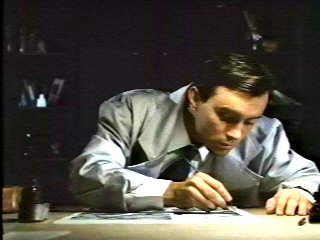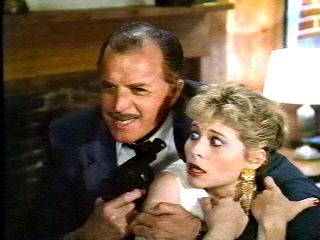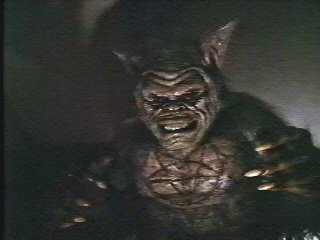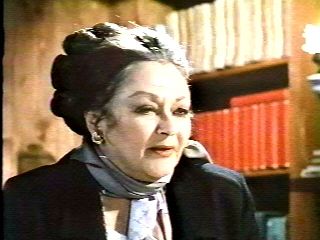
|
|
|
|
|
|
|
|
|
|
|
|
|
(1988) Director: John Carl Buechler
When I was a kid, even back then I was a committed
non-conformist. One of the ways it could be seen was in my choice of
reading material. Instead of obsessing over the Danny Dunn
series or that stupid Actually, the few other disappointments I ever encountered with my time with EC comics weren't because of finding a lack of gore, but instead from occasional lapses in storytelling. Every so often there was a story especially lazy and unimaginative, as if it had been suddenly whipped up just before a deadline. When I started to read one story that began with a man confessing to a friend he had just killed his wife, and in the subsequent flashback recalls how his chocoholic wife loved boxed chocolates divided into different sections, I instantly knew what would subsequently be shown in the "Good Lord!... Choke!..." panel on the last page. I recalled such unimaginative EC stories while I was watching Cellar Dweller. One of the last productions by Charles Band's Empire Pictures company, it was intended to be a tribute of sorts to those EC comics, but it ends up doing so in the wrong ways. The premise here, though not a blatant rip-off of any other work before it, will all the same seem very familiar to viewers. Especially since this time around, there apparently wasn't much of an effort to present it in a way that brought freshness or energy to the product. And during the actual filming, it seems nobody involved remembered that each EC story was only a few pages long, and didn't take an entire comic. There was a good reason for that - mainly, these stories didn't need any extra pages. Though the running time of Cellar Dweller is a brief 78 minutes (including closing credits), imagine one of those EC stories stretched out to fill an entire comic, and you'll have a good idea on how watching this movie feels like. The movie is not only a tribute to the old EC comics
with a story that could have come out of one of them, but with two of
the central characters being cartoonists with an interest in this
particular vein of comic book art. The first of these It's quite a place alright; mere seconds after new student Whitney Taylor (Farentino, NYPD Blue) arrives, the headmistress emphasizes to her the isolated nature of the place, adding, "We have no telephones, no ties with the outside world." Though that might make an excuse for the protagonists unable to get themselves out of the various predicaments to come, it doesn't excuse the fact that the house's basement - which used to be Childress' studio - has not been cleaned up for all of these decades and has been left to rot. Especially when Whitney during her snooping around discovers that among the debris a number of the possessions of Childress - who is now revered in the modern art world - have remained untouched. Whitney is agog by this discovery, because as an aspiring cartoonist, the work of Childress has been one of her major influences. You can tell this, because just like Childress was seen doing in the opening sequence, the way she draws comic book panels usually leaves no room for captions or speech balloons to be inserted without blocking an important part of the artwork. (Though the few times she does draw speech balloons and lettering, you quickly understand why.) So it shouldn't come as any surprise that during the cleaning-up music montage, she comes across that same mysterious book, and reveals she shares Childress' inclination towards plagiarism by also drawing what she reads in it - including the same title creature that had wrecked havoc with Childress decades earlier. No prizes for guessing that same mysterious creature
gets resurrected once Whitney takes pen in hand to illustrate it...
eventually. No prizes also for guessing that same mysterious creature
then starts a new and greater wave of havoc... slowly. It could be
debated if one can actually call what follows "havoc" despite the
bigger body count, because of the
The human characters make a similarly bland impression; in some cases, it could be argued that they are even more poorly constructed than the monster. Take the character of Norman (Edwards of Ben Casey fame) - what's the point of his being here? First of all, the school seemed to be geared to teach the young (though we never see any real classes or classrooms at any point), so why is a man pushing 60 years of age enrolled here, especially since this guy is (I think - it's not made clear) an aspiring detective novelist and not an artist? Sure, he does some snooping around at one point, and at first the purpose seems to be that he'll find evidence suggesting Whitney is directly behind the disappearances going on and thus heat will be focused on Whitney. But before Norman even gets close to blowing the whistle, he is quickly bumped off. (He does provide a not-bad decapitation, however.) Though Pamela Bellwood (Dynasty) does manage to pass off for someone younger than her actual age, her character proves to be equally useless. Like the character of Norman, at first her character (an old rival of Whitney) seems set up to provide some kind of plot turn somewhere along the line, but like Norman ends up simply becoming an addition to the body count before she can actually do anything of consequence. And while De Carlo's headmistress character hates comic books and isn't happy that Whitney is there to practice her interest, this too ends up going nowhere. The less said about the other supporting characters, the better. As for Whitney, the central protagonist, she really
doesn't come across any better than her fellow actors. While I wouldn't
call Farentino's performance awful, it's just... ordinary. Though it
isn't bad enough to distract, there is nothing about it To be fair about the ending... well, it gets worse than that. The movie refuses to have the movie and our suffering end after the climatic confrontation. After that "ending", there are subsequently three more, each one more desperate than the next. Apparently Buechler didn't know when enough was enough, and that's just one of the problems to be found with his direction. Though there are problems with it throughout (among other things, footage being reused) his biggest inability is in the horror sequences themselves. First of all, there are far too many false scares - hands on the shoulder and other such innocent surprises - and all of this "crying wolf" then makes it hard to take any legitimate stabs at horror or scares seriously. But even without all these cheap shots, it would still be hard to feel anything scary from the monster sequences. They are done in the worst ways possible, not just with their bad direction but with the technique of depicting much of each attack by repeatedly cutting to black-and-white comic book panels illustrating the monster poised, mauling, eating his victim, etc. This is not stylish, it smacks of laziness instead. If the director of a movie doesn't seem fully committed to his projected, then why should we, the audience, care any more than him? Check for availability on Amazon (VHS) See also: Crawlspace, Doorway, Elves |
 Random House joke
book in the school library that everyone else in my fourth grade class
was always checking out, my literary tastes were both different and
varied. My authors of choice ranged from the
finding-the-absurd-of-everything works of Daniel Pinkwater to the
tell-it-like-it-is prose of Don Pendelton. As for comic books, I didn't
collect or read them very much while growing up - that is, if they were
not EC comics. Tales From The Crypt, Vault Of Horror, Weird Science,
the whole shebang. No, of course I'm not that
old - I'm talking about reprints, of course. You can be sure that if I
ever found a reprinted EC comic or story, or even an article about EC
comics, I would seize the opportunity to read it. You can also be sure
I searched hard over the years to find the notorious Jack Davis-drawn Foul
Play - and maybe imagine my disappointment when I finally got a
hold of it and found it wasn't as gruesome as my young but already
perverted imagination thought it would be.
Random House joke
book in the school library that everyone else in my fourth grade class
was always checking out, my literary tastes were both different and
varied. My authors of choice ranged from the
finding-the-absurd-of-everything works of Daniel Pinkwater to the
tell-it-like-it-is prose of Don Pendelton. As for comic books, I didn't
collect or read them very much while growing up - that is, if they were
not EC comics. Tales From The Crypt, Vault Of Horror, Weird Science,
the whole shebang. No, of course I'm not that
old - I'm talking about reprints, of course. You can be sure that if I
ever found a reprinted EC comic or story, or even an article about EC
comics, I would seize the opportunity to read it. You can also be sure
I searched hard over the years to find the notorious Jack Davis-drawn Foul
Play - and maybe imagine my disappointment when I finally got a
hold of it and found it wasn't as gruesome as my young but already
perverted imagination thought it would be.  people we are
introduced is Colin Childress (Jeffrey Combs of
Re-Animator fame), one of the top of his field
in the 1950s. Though we never learn why he is wearing a lab coat when
we are introduced to him one night at work in front of his drawing
board, we do learn that recently he has been getting inspiration (more
like blatant plagiarism) for his stories from an ancient book, Curses
Of The Ancient Dead. Where did he get this book? What's the history
of this book? We never find the answers to these questions, but we
don't need to be told what his messing with an ancient tome will result
in. As predicted, it results in an ancient evil spirit being
resurrected, and the standard death and fiery destruction that usually
comes up in a case like this. Three decades later, despite its cramped
size, the Childress residence has been transformed into The
Throckmorton Institute For The Arts. You would think this location
would be a quite unlikely location to be chosen for a highly-respected
school that also houses its students, but since there are apparently
only five students and the headmistress (De Carlo, The Munsters)
dwelling and working there, perhaps it is appropriate after all.
(Though I can only imagine the tuition fees.)
people we are
introduced is Colin Childress (Jeffrey Combs of
Re-Animator fame), one of the top of his field
in the 1950s. Though we never learn why he is wearing a lab coat when
we are introduced to him one night at work in front of his drawing
board, we do learn that recently he has been getting inspiration (more
like blatant plagiarism) for his stories from an ancient book, Curses
Of The Ancient Dead. Where did he get this book? What's the history
of this book? We never find the answers to these questions, but we
don't need to be told what his messing with an ancient tome will result
in. As predicted, it results in an ancient evil spirit being
resurrected, and the standard death and fiery destruction that usually
comes up in a case like this. Three decades later, despite its cramped
size, the Childress residence has been transformed into The
Throckmorton Institute For The Arts. You would think this location
would be a quite unlikely location to be chosen for a highly-respected
school that also houses its students, but since there are apparently
only five students and the headmistress (De Carlo, The Munsters)
dwelling and working there, perhaps it is appropriate after all.
(Though I can only imagine the tuition fees.) painfully slow way Cellar
Dweller drags itself out in knocking off the supporting cast
one by one. But it's not just the snail-pace that robs this movie of
any chance of scaring us or giving us any feeling that the title
monster is a strong and dangerous malevolent force. The cellar dweller
itself is not a particularly interesting monster. I will admit that
(for a low budget) the visual look of the monster isn't so bad; it's an
appropriately hulking size, with some fine details you might not find
on a monster in another low budget horror movie. It designed by
directed Buechler himself, a long-time special effects/make-up artist
on many other Charles Band movies, many of which we coincidently (and
implausibly) see posters for hanging around on various walls of the art
school. But while the monster isn't bad visually, it has no real
personality that makes him "real", or even a real threat. He doesn't
seem to have the ability to walk around (or at least walk more than a
few slow steps at a time), so you have to wonder why his victims for
the most part don't even take a few brisk steps away from him. Earlier,
I mentioned how he originates from that generic ancient spell book that
has an unclear origin, so we never get any real idea what this
monster's history, purpose of being, or even personal motive is. All he
seems to want to do is swing his arms, kill people with his blows
(mostly offscreen), and eat them (mostly offscreen).
painfully slow way Cellar
Dweller drags itself out in knocking off the supporting cast
one by one. But it's not just the snail-pace that robs this movie of
any chance of scaring us or giving us any feeling that the title
monster is a strong and dangerous malevolent force. The cellar dweller
itself is not a particularly interesting monster. I will admit that
(for a low budget) the visual look of the monster isn't so bad; it's an
appropriately hulking size, with some fine details you might not find
on a monster in another low budget horror movie. It designed by
directed Buechler himself, a long-time special effects/make-up artist
on many other Charles Band movies, many of which we coincidently (and
implausibly) see posters for hanging around on various walls of the art
school. But while the monster isn't bad visually, it has no real
personality that makes him "real", or even a real threat. He doesn't
seem to have the ability to walk around (or at least walk more than a
few slow steps at a time), so you have to wonder why his victims for
the most part don't even take a few brisk steps away from him. Earlier,
I mentioned how he originates from that generic ancient spell book that
has an unclear origin, so we never get any real idea what this
monster's history, purpose of being, or even personal motive is. All he
seems to want to do is swing his arms, kill people with his blows
(mostly offscreen), and eat them (mostly offscreen). that makes you
remember it once the movie has ended. There is also little about her
character that's of any notice, aside from the fact she has the amazing
ability to ink an entire comic book page without previously using a
pencil to sketch, even for the panel divisions. Though it certainly is
a change to portray a comic book artist as a woman in a movie, nothing
is done in the movie to use this change to bring in anything different
than if Whitney was male. The fact that she is a woman probably happens
to be one of the many attempts by the movie to distract the audience
from the fact that, for most of the running time, there is really
nothing going on. The first part of the movie has the characters
shuffling around and trying to look busy until the monster appears.
Then the second half of the movie more or less consists of the monster
knocking off everyone. Though that kind of thing is certainly found in
other horror movies, this time around there's even less of a point. As
I said, the monster isn't that threatening, and there's no feeling that
it could bring any more danger apart from knocking off some pretty
boring characters. We certainly see a lot of these characters "in
action" throughout; Pamela's character in one scene wanders around the
basement for a long time (and ends up doing nothing), another student
spends several minutes enacting a lame "performance piece" for her
peers, and Whitney not only has a dream sequence, but also has a
lengthy daydream. So there's not exactly a lot being done to build any
tension, especially when there is absolutely no question on how the
monster will be dealt with in the end - the movie was generous enough
to illustrate the monster's weakness in the opening sequence. Though
since you already know the monster comes from ink and paper, you
probably more or less guessed the solution already.
that makes you
remember it once the movie has ended. There is also little about her
character that's of any notice, aside from the fact she has the amazing
ability to ink an entire comic book page without previously using a
pencil to sketch, even for the panel divisions. Though it certainly is
a change to portray a comic book artist as a woman in a movie, nothing
is done in the movie to use this change to bring in anything different
than if Whitney was male. The fact that she is a woman probably happens
to be one of the many attempts by the movie to distract the audience
from the fact that, for most of the running time, there is really
nothing going on. The first part of the movie has the characters
shuffling around and trying to look busy until the monster appears.
Then the second half of the movie more or less consists of the monster
knocking off everyone. Though that kind of thing is certainly found in
other horror movies, this time around there's even less of a point. As
I said, the monster isn't that threatening, and there's no feeling that
it could bring any more danger apart from knocking off some pretty
boring characters. We certainly see a lot of these characters "in
action" throughout; Pamela's character in one scene wanders around the
basement for a long time (and ends up doing nothing), another student
spends several minutes enacting a lame "performance piece" for her
peers, and Whitney not only has a dream sequence, but also has a
lengthy daydream. So there's not exactly a lot being done to build any
tension, especially when there is absolutely no question on how the
monster will be dealt with in the end - the movie was generous enough
to illustrate the monster's weakness in the opening sequence. Though
since you already know the monster comes from ink and paper, you
probably more or less guessed the solution already.